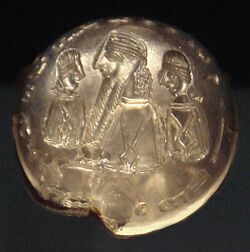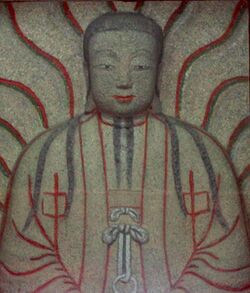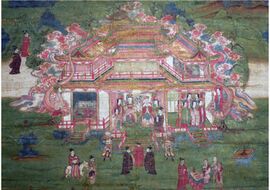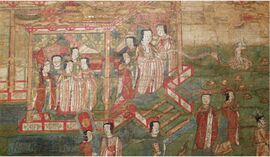Mani (prophet)
Topic: Biography
 From HandWiki - Reading time: 14 min
From HandWiki - Reading time: 14 min
Mani | |
|---|---|
مانی | |
 | |
| Preceded by | Jesus |
| Personal | |
| Born | c. April AD 216 |
| Died | 2 March AD 274 or 26 February AD 277[5] (aged 57–58 or 60–61) Gundeshapur, Sasanian Empire (modern-day Iran) |
| Cause of death | Execution by the order of Bahram I |
| Religion | Manichaeism |
| Nationality | Iranian |
| Parents | Pātik, Mariam |
| Citizenship | Template:Country data Sasanian Empire |
| Notable work(s) | Manichaean scripture |
| Founder of | Manichaeism |
Mani[lower-alpha 1] (c. April AD 216–2 March AD 274 or 26 February AD 277) was an Iranian[6][7][8][9] prophet and the founder of Manichaeism, a religion most prevalent in late antiquity.
Mani was born in or near Seleucia-Ctesiphon (south of modern Baghdad) in Mesopotamia,[4] at the time part of the Parthian Empire. Seven of his major works were written in Syriac, and the eighth, dedicated to the Sasanian emperor Shapur I, was written in Middle Persian.[10] He died in Gundeshapur.
Etymology
The exact meaning of the name is a question still unsolved.[11] It may have derived from Babylonian-Aramaic Mânâ [luminescence]. Mandaeans used the term mânâ rabba, which means "Enlightened Lord/King".[12] Ancient Greek interpretations were skeuos (σκεῦος, vessel, instrument) and homilia (ὁμιλία, intercourse, company, communion, instruction).[clarification needed]
The same slightly contemptuous "a certain" (Manes quidam) also appears in Hegemonius' Acta Archelai (4th century), however, Hegemonius contributes a detailed description of Mani's looks. Mani’s names became the object of uplifting transformation (Greek, Coptic Mannichaios, Latin Mannichaeus, i.e., Mannam fundens "pouring out Manna"). Alternatively, due to Mani's possible origins in an Elchasai community, "Mani" could be a Hypocorism of the Hebrew name Menahem ("the consoler" or "comforter"). [13][14]
Sources
In 1969 in Upper Egypt a Greek parchment codex dating to c. AD 400 was discovered. It is now designated Codex Manichaicus Coloniensis because it is conserved at the University of Cologne. Combining a hagiographic account of Mani's career and spiritual development with information about Mani's religious teachings, and containing fragments of his writings, it is now considered the most reliable source of information about the historical Mani.
All other medieval and pre-medieval accounts of his life are either legendary or hagiographical, such as the account in Fihrist by Ibn al-Nadim, purportedly by al-Biruni, or were anti-Manichaean polemics, such as the 4th-century Acta Archelai. Among these medieval accounts, Ibn al-Nadim's account of Mani's life and teachings is generally speaking the most reliable and exhaustive. Notably, the (in other accounts prominent) image of the "Third Ambassador" is only represented through a brief mention of the name bašīr, "messenger of good news", and the topos of "Mani the Painter" (which in other Islamic accounts almost completely replaces that of "the founder of a religion") is completely absent.[15]
Life
This work and other evidence discovered in the 20th century establishes Mani as a historical individual.[16] For an updated critique of the standard account and a radically alternative proposal see Iain Gardner's The Founder of Manichaeism: Rethinking the Life of Mani.[17]
Early life
Mani was born near Seleucia-Ctesiphon, perhaps in the town Mardinu in the Babylonian district of Nahr Kutha; according to other accounts in the town Abrumya. Mani's father Pātik (Middle Persian Pattūg;[18] Koinē Greek: Παττικιος, Arabic: Futtuq), a native of Ecbatana[19] (now Hamadan, Iran), was a member of the Jewish Christian sect of the Elcesaites. His mother was of Parthian descent[20][21] (from "the Armenian Arsacid family of Kamsarakan"[22]); her name is reported variously, among others Maryam.
Mani was raised in a heterodox environment in Babylon. The Elcesaite community was ostensibly Jewish Christian, though with some Gnostic features due to their Ebionite heritage, such as the belief in recurring incarnations of heavenly apostles, one of whom was a docetic Christ. At ages 12 and 24 Mani had visionary experiences of a "heavenly twin" of his (syzygos), calling him to leave his father's sect and preach the true message of Jesus in a new gospel.[23][24] It is said that his appearance was a mixture of Iranian and Mesopotamian features. On the one hand he looked like a warrior, on the other like a magician. In some later texts he was described as lame, a characteristic possibly attributed to him by his opponents.[25]
Travelling to India
Mani then travelled to India (Sakas in present day Afghanistan), where he studied Hinduism and its various extant philosophies, as well as Buddhism.[8] Al-Biruni says Mani only traveled to India after being banished from Persia,[26] but this might be an error or a second journey.[8] It is believed that his Christian roots might have been influenced by Marcion and Bardaisan.[27]
Return from India
Returning in 242, Mani presented himself to Shapur I, to whom he dedicated his only work written in Persian, known as the Shabuhragan. Shapur was not converted to Manichaeism and remained Zoroastrian, but he favored Mani's teachings, which mixed Christianity, Buddhism and Zoroastrianism, and took him into his court.[8][28] Mani is said to have performed miracles, including levitation, teleporting and healing, which helped him to gain converts in the Iranian elite. He was also famed as a painter.[8]
Imprisonment and execution
Shapur's successor Hormizd I, who reigned only for one year, continued to patronize Mani, but his successor Bahram I, a follower of the intolerant Zoroastrian reformer Kartir,[29] began to persecute the Manichaeans. He incarcerated Mani, who died in prison within a month, in 274. According to sources, he passed his last days comforting his visiting disciples, teaching that his death would have no other consequence than the return of his soul to the realm of light.[8]
Mani's followers depicted Mani's death as a crucifixion in a conscious analogy to the crucifixion of Jesus; al-Biruni says that Bahram ordered the execution of Mani. There is a story which claims that he was flayed, and his corpse suspended over the main gate of the great city of Gundeshapur;[30] however, there is no historical basis for this account.[31] It is more plausible that his body was mutilated via post-mortem decapitation, and his head put on display, which may be the original source of the embellishment.[14]
Works
The canon of Mani includes six works originally written in Syriac, and one in Persian, the Shapuragan. While none of his books have survived in complete form, there are numerous fragments and quotations of them, including a long Syriac quotation from one of his works, as well as a large amount of material in Middle Persian, Coptic, and numerous other languages.
Examples of surviving portions of his works include: the Shabuhragan (Middle Persian), the Book of Giants (numerous fragments in many languages), the Fundamental Epistle (quoted in length by Saint Augustine), a number of fragments of his Living Gospel (or Great Gospel), a Syriac excerpt quoted by Theodore Bar Konai, and his Letter to Edessa contained in the Cologne Mani-Codex. Mani also wrote the book Arzhang, a holy book of Manichaeism unique in that it contained many drawings and paintings to express and explain the Manichaeist creation and history of the world.
Teaching
Mani's teaching was intended to "combine",[32] succeed, and surpass the teachings of Christianity, Zoroastrianism, Buddhism, Marcionism,[32] Hellenistic and Rabbinic Judaism, Gnostic movements, Ancient Greek religion, Babylonian and other Mesopotamian religions,[33] and mystery cults.[34][12] It is based on a rigid dualism of good and evil, locked in eternal struggle, which was a "familiar mytholog[ical]" element of the time in many spiritual traditions that Mani deliberately borrowed.[34]
In his mid-twenties, Mani decided that salvation was possible through education, self-denial, fasting and chastity. According to Al-Biruni, a 10th-century Iranian scholar, Mani claimed to be the Paraclete promised in the New Testament, and the Last Prophet.[35] However according to Lodewijk J. R. Ort, the term last prophet may "in all probability derived from the Quran by Al-Buruni in order to formulate Mani's pretensions and religious claims".[36] Therefore Lodewijk J. R. Ort concludes that a definitive pronouncement about the final character of Mani's appearance is not mentioned in Manichaeistic scriptures.[37]
According to Christian eschatology, Jesus, not Mani, will perform the final judgment at the conclusion of history.[38]
While his religion was not strictly a movement of Christian Gnosticism in the earlier mode, Mani did declare himself to be an "apostle of Jesus Christ",[32] and extant Manichaean poetry frequently extols Jesus and his mother, Mary, with the highest reverence. Manichaean tradition also claims that Mani was the reincarnation of different religious figures including Jesus, Zoroaster, and the historical Buddha.
Mani's followers were organized in a church structure, divided into a class of "elects" (electi) and "auditors" (auditores). Only the electi are required to follow the laws strictly, while the auditores care for them, hoping to become electi in their turn after reincarnation.
Christian and Islamic tradition
Late Antique Christian accounts in the West
The Western Christian tradition of Mani is based on Socrates of Constantinople, a historian writing in the 5th century. According to this account, one Scythianos, a Saracen, husband of an Egyptian woman, "introduced the doctrine of Empedocles and Pythagoras into Christianity"; that he had a disciple, "Buddas, formerly named Terebinthus," who travelled in Persia, where he alleged that he had been born of a virgin, and afterwards wrote four books, one of Mysteries, a second The Gospel, a third The Treasure, and a fourth Heads. While performing some mystic rites, he was hurled down a precipice by a daimon, and killed.[39]
A woman at whose house he lodged buried him, took over his property, and bought a boy of seven, named Cubricus. This boy she freed and educated, leaving him the property and books of Buddas-Terebinthus. Cubricus then travelled into Persia, where he took the name of Manes and gave forth the doctrines of Buddas Terebinthus as his own. The king of Persia, hearing that he worked miracles, sent for him to heal his sick son, and on the child's dying put Manes in prison. Thence he escaped, flying into Mesopotamia, but was traced, captured, and flayed alive by the Persian king's orders, the skin being then stuffed with chaff and hung up before the gate of the city.[39]
According to Jerome, Archelaus wrote his account of his disputation with "Manichæus" in Syriac, whence it was translated into Greek. The Greek is lost, and the work, apart from extracts, subsists only in a Latin translation from the Greek, of doubtful age and fidelity, probably made after the 5th century. By Photius it is stated that Heraclean, bishop of Chalcedon, in his book against the Manichæans, said the Disputation of Archelaus was written by one Hegemonius, an author not otherwise traceable, and of unknown date.[39]
In the Latin narrative, "Manes" is said to have come, after his flight from court, from Arabion, a frontier fortress, to Caschar or Carchar, a town said to be in Roman Mesopotamia, in the hope of converting an eminent Christian there, named Marcellus, to whom he had sent a letter beginning: "Manichæus apostle of Jesus Christ, and all the saints and virgins with me, send peace to Marcellus." In his train he brought twenty-two (or twelve) youths and virgins.[39]
At the request of Marcellus, he debated on religion with bishop Archelaus, by whom he was vanquished, whereupon he set out to return to Persia. On his way he proposed to debate with a priest at the town of Diodorides. But Archelaus came to take the priest's place, and again defeated him, whereupon, fearing to be given up to the Persians by the Christians, he returned to Arabion.[39]
At this stage Archelaus introduces in a discourse to the people his history of "this Manes," very much to the effect of the recapitulation in Socrates. Among the further details are these: that Scythianus lived "in the time of the Apostles", that Terebinthus said the name of Buddas had been imposed on him, that in the mountains he had been brought up by an angel, that he had been convicted of imposture by a Persian prophet named Parcus, and by Labdacus, son of Mithra.[39]
Furthermore, that in the disputation he taught concerning the sphere, the two luminaries, the transmigration of souls, and the war of the Principia against God, that "Corbicius" or Corbicus, about the age of sixty, translated the books of Terebinthus. He made three chief disciples, Thomas, Addas, and Hermas, of whom he sent the first to Egypt, and the second to Scythia, keeping the third with him. The two former returned when he was in prison, and that he sent them to procure for him the books of the Christians, which he then studied. According to the Latin narrative, finally, Manes on his return to Arabion was seized and taken to the Persian king, by whose orders he was flayed, his body being left to the birds, and his skin, filled with air, hung at the city gate.[39]
Medieval Islamic accounts

Mani is described as a painter who set up a sectarian movement in opposition to Zoroastrianism. He was persecuted by Shapur I and fled to Central Asia, where he made disciples and embellished with paintings a Tchighil (or picturarum domus Chinensis) and another temple called Ghalbita. Provisioning in advance a cave which had a spring, he told his disciples he was going to heaven, and would not return for a year, after which time they were to seek him in the cave in question. They then came back there after a year and found him, whereupon he showed them an illustrated book, called Ergenk, or Estenk Arzhang, which he said he had brought from heaven.[39]
Whereafter he had many followers, with whom he returned to Persia at the death of Shapur. The new king, Hormisdas, joined and protected the sect, and built Mani a castle. The next king, Bahram or Varanes, at first favoured Mani. After getting him to debate with certain Zoroastrian teachers, caused him to be flayed alive, and his skin to be stuffed and hung up. Thereupon most of his followers fled to India and China.[39]
See also
- Mar Ammo
- Arzhang
- Cologne Mani-Codex
- The Gardens of Light
- Gospel of Mani
- Mandaeism
Notes
- ↑ Middle Persian: 𐭌𐭀𐭍𐭉/𐭬𐭠𐭭𐭩/𐮋𐮀𐮌𐮈/𐬨𐬁𐬥𐬌/𐫖𐫀𐫗𐫏 Māni, New Persian: مانی Māni, Chinese: 摩尼 Móní, Syriac Mānī, Greek Μάνης, Latin Manes; also Μανιχαῖος, Latin Manichaeus, from Syriac ܡܐܢܝ ܚܝܐ Mānī ḥayyā "Living Mani"
References
- ↑ 1.0 1.1 Grenet, Frantz (2022). Splendeurs des oasis d'Ouzbékistan. Paris: Louvre Editions. p. 93. ISBN 978-8412527858.
- ↑ "Believers, Proselytizers, & Translators The Sogdians". https://sogdians.si.edu/believers-proselytizers-translators/.
- ↑ GULÁCSI, ZSUZSANNA (2010). "The Prophet's Seal: A Contextualized Look at the Crystal Sealstone of Mani (216-276 C.E.) in the Bibliothèque nationale de France". Bulletin of the Asia Institute 24: 164. ISSN 0890-4464. https://www.jstor.org/stable/pdf/43896125.pdf.
- ↑ 4.0 4.1 Taraporewala, I.J.S., Manichaeism, Iran Chamber Society, http://www.iranchamber.com/religions/articles/manichaeism2.php, retrieved 2015-01-12
- ↑ SASANIAN DYNASTY, http://www.iranicaonline.org/articles/sasanian-dynasty, retrieved 2015-01-12
- ↑ Boyce, Mary (2001), Zoroastrians: their religious beliefs and practices, Routledge, p. 111, "He was Iranian, of noble Parthian blood..."
- ↑ Ball, Warwick (2001), Rome in the East: the transformation of an empire, Routledge, p. 437, "Manichaeism was a syncretic religion, proclaimed by the Iranian Prophet Mani".
- ↑ 8.0 8.1 8.2 8.3 8.4 8.5 Sundermann, Werner (2009-07-20), MANI, Sundermann, https://www.iranicaonline.org/articles/mani-founder-manicheism, "According to the Fehrest, Mani was of Arsacid stock on both his father’s and his mother’s sides, at least if the readings al-ḥaskāniya (Mani’s father) and al-asʿāniya (Mani’s mother) are corrected to al-aškāniya and al-ašḡāniya (ed. Flügel, 1862, p. 49, ll. 2 and 3) respectively. The forefathers of Mani’s father are said to have been from Hamadan and so perhaps of Iranian origin (ed. Flügel, 1862, p. 49, 5–6). The Chinese Compendium, which makes the father a local king, maintains that his mother was from the house Jinsajian, explained by Henning as the Armenian Arsacid family of Kamsarakan (Henning, 1943, p. 52, n. 4 = 1977, II, p. 115). Is that fact, or fiction, or both? The historicity of this tradition is assumed by most, but the possibility that Mani’s noble Arsacid background is legendary cannot be ruled out (cf. Scheftelowitz, 1933, pp. 403–4). In any case, it is characteristic that Mani took pride in his origin from time-honored Babel, but never claimed affiliation to the Iranian upper class."
- ↑ Bausani, Alessandro (2000), Religion in Iran: from Zoroaster to Baha'ullah, Bibliotheca Persica Press, p. 80, "We are now certain that Mani was of Iranian stock on both his father's and his mother's side".
- ↑ Henning, W.B., The Book of Giants, BSOAS, Vol. XI, Part 1, 1943, pp. 52–74: "...Mani, who was brought up and spent most of his life in a province of the Persian empire, and whose mother belonged to a famous Parthian family, did not make any use of the Iranian mythological tradition. There can no longer be any doubt that the Iranian names of Sām, Narīmān, etc., that appear in the Persian and Sogdian versions of the Book of the Giants, did not figure in the original edition, written by Mani in the Syriac language."
- ↑ O. Klima, Manis Zeit und Leben, Prague, 1962.
- ↑ 12.0 12.1 Arendzen, John (1910-10-01). "Manichæism". The Catholic Encyclopedia. Vol. 9. New York: The Encyclopedia Press, Inc.
- ↑ J. Tubach and M. Zakeri ‘Mani’s Name,’ in J van Oort, O Wermelinger and G Wurst editors, Augustine and Manichaeism in the Latin West: Proceedings of the Fribourg-Utrecht International Symposium of the IAMS (Nag Hammadi and Manichaean Studies 49), Leiden, 2001, pg 274-275.
- ↑ 14.0 14.1 Sundermann, Werner (2009-07-20). "MANI" (in en-US). Encyclopædia Iranica Foundation. https://iranicaonline.org/articles/mani-founder-manicheism.
- ↑ W. Sundermann, "Al-Fehrest, iii. Representation of Manicheism.", Encyclopaedia Iranica, 1999.
- ↑ Böhlig, Manichäismus, 5ff.
- ↑ Gardner, Iain. The founder of Manichaeism: rethinking the life of Mani. Cambridge University Press, 2020.
- ↑ D. N. MacKenzie. A Concise Pahlavi Dictionary. Routledge Curzon, 2005.
- ↑ Mani (Iranian religious leader) at the Encyclopædia Britannica
- ↑ Henning, Walter Bruno (1943). The Book of the Giants. University of London. pp. 52–74. https://books.google.com/books?id=kVc5cAAACAAJ. "It is noteworthy that Mani, who was brought up and spent most of his life in a province of the Persian empire, and whose mother belonged to a famous Parthian family, did not make any use of the Iranian mythological tradition. There can no longer be any doubt that the Iranian names of Sām, Narīmān, etc., that appear in the Persian and Sogdian versions of the Book of the Giants, did not figure in the original edition, written by Mani in the Syriac language."
- ↑ W. Eilers (1983), "Iran and Mesopotamia" in E. Yarshater, The Cambridge History of Iran, vol. 3, Cambridge: Cambridge University Press, p. 500: "Mani, a Parthian on his mother's side, was born at Ctesiphon in the last decade of the Arsacid era (AD 216). "
- ↑ Sundermann, Werner (2009), Mani, the founder of the religion of Manicheism in the 3rd century CE, http://www.iranicaonline.org/articles/mani-founder-manicheism, "...his mother was from the house Jinsajian, explained by Henning as the Armenian Arsacid family of Kamsarakan".
- ↑ Wearring, Andrew (2008-09-19). "Manichaean Studies in the 21st Century" (in en). Sydney Studies in Religion. ISSN 1444-5158. https://openjournals.library.sydney.edu.au/index.php/SSR/article/view/254.
- ↑ Henrichs, Albert (1979). "The Cologne Mani Codex Reconsidered". Harvard Studies in Classical Philology 83: 339–367. doi:10.2307/311105. ISSN 0073-0688.
- ↑ Hajianfard, Ramin (2016). Mani and the Foundation of Manichaeism: Great Events in Religion: An Encyclopedia of Pivotal Events in Religion History. Santa Barbara: ABC-CLIO. p. 188. ISBN 9781610695657. OCLC 938999818.
- ↑ Sachau, Edward C. (1910). Alberuni's India. London.
- ↑ Dimitri Obolensky (2004). The Bogomils: A Study in Balkan Neo-Manichaeism. Cambridge University Press. ISBN 9780521607636.
- ↑ Bautz, Traugott, ed (1993). "Mani (iran. Mānī<; Koinē Greek: Μανιχαῑος < ostaram. Mānī ḥayyā »der lebendige Mani«)" (in de). Biographisch-Bibliographisches Kirchenlexikon (BBKL). 5. Herzberg: Bautz. cols. 669–80. ISBN 3-88309-043-3. http://www.bbkl.de/m/mani.shtml.
- ↑ Shahbazi, A. Sh. (2016-07-26). "Bahrām I" (in en-US). Encyclopædia Iranica Foundation. https://iranicaonline.org/articles/bahram-01.
- ↑ Al-Biruni. The Chronology of Ancient Nations.
- ↑ Bevan, A. A. (1930). "Manichaeism". Encyclopaedia of Religion and Ethics, Volume VIII. Ed. James Hastings. London.
- ↑ 32.0 32.1 32.2 Turner, Alice K. (1993) (in en-US). The History of Hell (1st ed.). United States: Harcourt Brace. pp. 50. ISBN 978-0-15-140934-1.
- ↑ Widengren, Geo Mesopotamian elements in Manichaeism (King and Saviour II): Studies in Manichaean, Mandaean, and Syrian-gnostic religion, Lundequistska bokhandeln, 1946.
- ↑ 34.0 34.1 Hopkins, Keith (July 2001). A World Full of Gods: The Strange Triumph of Christianity. New York: Plume. pp. 246, 263, 270. ISBN 0-452-28261-6. OCLC 47286228. https://www.worldcat.org/oclc/47286228.
- ↑ al-Biruni, Muhammad ibn Ahmad; Eduard Sachau ed.; The Chronology of Ancient Nations; p. 190; W. H. Allen & Co.; London: 1879
- ↑ Mani: a religio-historical description of his personality. By L. J. R. Ort. Leiden, E. J. Brill, 1967. pp. 123–124.
- ↑ L. J. R. Ort (1967). Ibid Mani: A Religio-historical Description of His Personality. pp. 124. "Unfortunately the text breaks off after the comig of Mani is mentioned [...] we cannot say if this contained a pronouncement about the final character of Mani's appearance"
- ↑ Gilles Quispel. “Hermes Trismegistus and the Origins of Gnosticism.” Vigiliae Christianae, vol. 46, no. 1, 1992, p. 15. JSTOR website Retrieved 24 June 2023.
- ↑ 39.0 39.1 39.2 39.3 39.4 39.5 39.6 39.7 39.8 John M. Robertson, Pagan Christs (2nd ed. 1911), § 14. The Problem of Manichæus, online at http://www.sacred-texts.com
Sources
- Asmussen, Jes Peter, comp., Manichaean Literature: Representative Texts, Chiefly from Middle Persian and Parthian Writings, 1975, Scholars' Facsimiles & Reprints, ISBN:978-0-8201-1141-4.
- Alexander Böhlig, 'Manichäismus' in: Theologische Realenzyklopädie 22 (1992), 25–45.
- Griffith, Sidney H. (2002). "Christianity in Edessa and the Syriac-Speaking World: Mani, Bar Daysan, and Ephraem, the Struggle for Allegiance on the Aramean Frontier". Journal of the Canadian Society for Syriac Studies 2: 5–20. doi:10.31826/jcsss-2009-020104. http://www.syriacstudies.com/2018/11/29/christianity-in-edessa-and-the-syriac-speaking-world-mani-bar-daysan-and-ephraem-the-struggle-for-allegiance-on-the-aramean-frontier-by-sidney-griffith. Retrieved 2020-11-27.
- Amin Maalouf, The Gardens of Light [Les Jardins de Lumière], translated from French by Dorothy S. Blair, 242 p. (Interlink Publishing Group, New York, 2007). ISBN:1-56656-248-1
- Mitchell, Charles W., ed (1912). S. Ephraim's Prose Refutations of Mani, Marcion, and Bardaisan. 1. London: Text and Translation Society. https://books.google.com/books?id=HkJIAQAAIAAJ.
- S. Ephraim's Prose Refutations of Mani, Marcion, and Bardaisan. 2. London: Text and Translation Society. 1921. https://books.google.com/books?id=B2VIAQAAIAAJ.
External links
- Manichaeist art - University of Washington
- "Mani and Manichaeism in the J.R.Ritman Library"
- The Book of the Giants by W.B. Henning, 1943
- Acta Archelai
 |
 KSF
KSF




